Download a PDF of this Backgrounder
James Gimpel is a professor of government at the University of Maryland, College Park.
Summary
- Many observers are puzzling over the voters’ choice of Donald Trump as the 2016 Republican nominee for president. Part of the puzzle can be resolved by understanding that Trump was close to the GOP grassroots on a number of important policy priorities, including immigration.
- Immigration policy choices have become increasingly partisan over time, as many other policies have. This is a long-term trend, not an overnight development.
- Opinion polls leading up to 2016 were increasingly clear about where GOP voters stood on a range of immigration policy matters, including legalization for undocumented immigrants and border control. Surveys from multiple sources point in the same direction.
- When Donald Trump announced in June 2015, it is not so surprising that his vocal stand on immigration immediately fueled his popularity.
- In hindsight, Trump’s rise is less surprising than the fact that other contenders for the nomination flatly ignored clear signposts in numerous public opinion polls.
- Though there are other explanations for Trump’s success in the primaries, it should not be shocking that candidates win when they position themselves proximate to voters on issues as important as immigration policy and economic recovery.
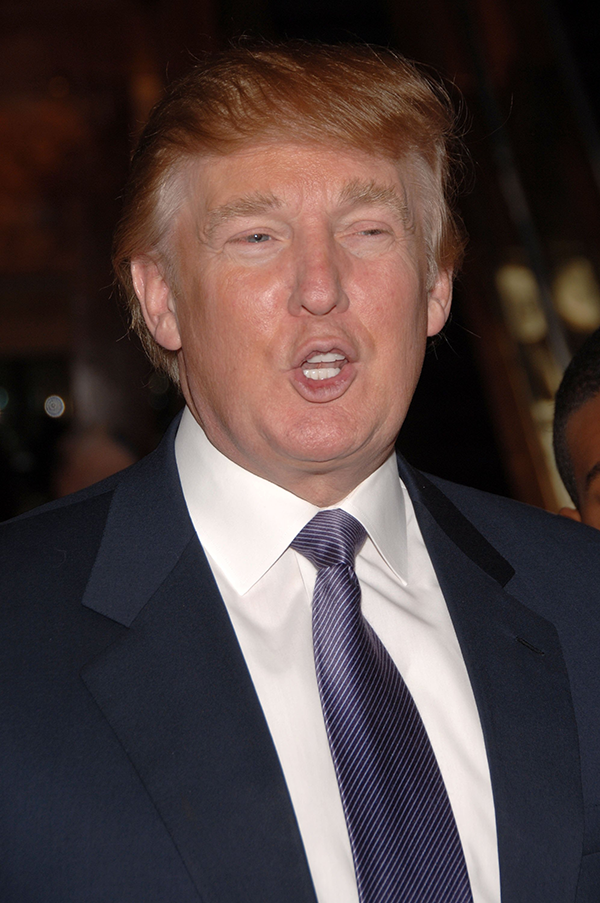
By now it is not news that Donald Trump’s fast rise among Republican primary voters rests in part on his stand on immigration control,1 and particularly his pungent criticism of the illegal immigration flow. His widely covered announcement speech in June 2015 in which he promised he would build a border wall if elected, and make Mexico pay for it, captured the support of voters as much for its audacity as for the substance of the proposal itself. With an opposition parceled out across more than a dozen rivals for the GOP nomination, adhering to issue positions popular among a sizable share of Republican voters fueled his momentum through the presidential primaries as competitors successively dropped out.
On the one hand, it should come as no surprise that a candidate’s courage to take positions popular with voters propelled him to victory. After all, according to leading theories of candidacy, election winners are ordinarily those whose viewpoints match those of their constituency on leading issues. What is more surprising, indeed, is that Trump was about the only candidate to stake out such clear-cut positions. Was public opinion on immigration cloudy or unclear? If Republicans held to clear positions, but were evenly split, sending mixed signals, that might explain the discrepancy between mass and elite views. So what does a review of immigration policy opinion, by political party, reveal?
An examination of various public opinion polls leading up to the 2015-16 election cycle demonstrates that public opinion on immigration was far from unclear, either among registered voters more generally, or among Republicans in particular. If other candidates chose to ignore public opinion by adopting unpopular positions, perhaps they concluded that their other strengths compensated. Some observers have speculated that adopting politically popular positions against immigration risked alienating important Republican donors that favor more liberal immigration policies.2 Certainly there was widespread press coverage in the initial months of the cycle about how influential donors were pushing for legal status for illegal immigrants, and related reforms.3
Regardless of the viewpoints of leading donors, however, if public opinion was unclear, and the early-cycle voters didn’t much care about immigration, Republican candidates could be forgiven for focusing their attention elsewhere. If opinion was clear, primary voters cared a great deal and candidates ignored them anyway, they miscalculated, took bad advice, and their poor performance is less excusable.
Long-Term Trends
Public opinion is intermittently measured on immigration issues by major media and reputable survey research firms. For example, Figure 1 displays tabulations from the Gallup poll series asking whether immigration should be increased, decreased, or remain the same, from February 1999 through June 2015. After accounting for the margin of error in these survey estimates, opinions on immigration levels have been pretty stable. Extending back to 1999, combined opinion favoring maintenance of present levels or desiring a decrease in immigration ranges across a 20-point supermajority from 70 to 90 percent. An average of 36 percent favor present levels of immigration and an average of 44 percent favor a decrease. The range of fluctuation has been narrower since 2012, suggesting opinion has been even more stable since the last presidential election.

In surveys since 2014, Gallup has recorded support for an increase in immigration to run as high as 27 percent, but not among Republicans, where only an estimated 15 percent report a desire to increase immigration.
Reports based on CBS News/New York Times surveys are quite consistent with the Gallup surveys, as they regularly ask a similar question, “Should immigration to the United States be kept at its present level, increased, or decreased?” In the majority of surveys since the mid-90s, a majority or solid plurality has favored a decrease, and similar to Gallup, never has the percentage favoring increased immigration exceeded 25 percent.
Opinion on immigration levels has unquestionably become more partisan over the years, as Republican voters have favored stricter enforcement and reduction of overall numbers, while Democrats have settled into a more open-door posture.
A 1965 Gallup survey showed that while few Americans favored increased immigration at the time, Republicans and Democrats were divided internally, with similar shares of respondents in both parties favoring a decrease. In 1977, a survey continued to show that partisan differences were negligible. In 1986, as the Immigration Reform and Control Act (IRCA) was passing with a bipartisan congressional majority, a CBS News/New York Times poll recorded no statistically significant partisan differences in opinion toward overall immigration levels. Given this history, it is curious that by 2016 the party followings have come to differ so widely in their thinking.
The dawn of a more partisan division in mass opinion on immigration arrived in the 1990s, as the Republican-controlled House took up immigration legislation shortly after their sweeping 1994 victory. The 9-11 terrorist attacks brought about a temporary uptick in sentiment favoring immigration restriction, but voters soon recovered a sense that legal immigration was a policy question separable from both illegal immigration and homeland security. Public opinion also began to reflect the complexity of the policy debate, as more voters came to express views on illegal immigration that were distinct from their opinions about legal immigrants.
By early 2015, thanks to regular polling, it had become increasingly clear where voters, Republicans and Democrats, stood on a range of immigration policies, at least for anyone paying attention.4 On the very general question of increasing immigration levels, few favored any increase in immigration, and a widening partisan gulf separated those who did from those who didn’t.
On specific aspects of immigration policy, such as addressing illegal immigration, the partisan division in opinion was also sharp and striking. For example, in surveys conducted early in 2015, CNN/ORC asked respondents, “How important will illegal immigration be to your vote for president next year?” In both February and June, more Republican than Democratic respondents reported that immigration would be a “very” or “extremely” important issue in the coming presidential election. The result from the combined polls can be seen in Table 1.

Notably, the partisan gap reporting immigration to be extremely/very important to their vote is 16 percentage points. The importance of immigration as a theme was probably inflated in summer (2015) polling by the Trump announcement. Even so, the sizable three-fourths Republican majority at this critical point in the pre-primary period probably explains Trump’s immediate competitiveness upon entry. In addition to the celebrity wattage he brought to the race, he was tuned into grassroots opinion to an extent that other Republican candidates were not.
There is always the possibility that the partisan gap in immigration’s importance seen in Table 1 is better explained by characteristics other than party identification. Perhaps it is really a matter of income or education level, or race and ethnicity, or age, and not party. Further tests of the relationship using standard statistical tools revealed that the partisan difference holds up after controlling for these other voter attributes (see Appendix Table A1). Even being of Latino or Asian ancestry does not matter to the importance of immigration as much as partisan identity does. Notably, respondents with higher levels of education and income are more likely to report that immigration is less important than those in lower education and income brackets. These results reinforce the impression that immigration divides voters by their socioeconomic status, in addition to their party loyalty.
To be sure, this survey question leaves unanswered the critical question of what voters prefer to be done about illegal immigration. Presumably, many Democrats who believe immigration to be an important issue would do something other than build a wall to prevent it. Some might prefer a plan to legalize illegal immigrants, for example, as the 2013 Gang of Eight legislation proposed. Fortuitously, other questions on early-cycle CNN/ORC surveys do address specific policy options, albeit in a simplified form.
For example, an important additional query asks about the appropriate way to address illegal immigration, as follows: “What should be the main focus of the U.S. government in dealing with the issue of illegal immigration — developing a plan that would allow illegal immigrants who have jobs to become legal U.S. residents, or developing a plan for stopping the flow of illegal immigrants into the U.S. and for deporting those already here?”
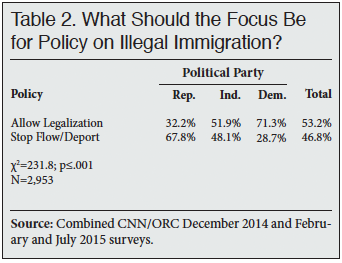
This question is posed in three early-cycle polls currently available for analysis: December 2014 and February and July 2015. In the combined surveys, an unmistakable partisan division is present in viewpoints about the direction illegal immigration policy should take. A greater than two-thirds majority of Republicans prefers that public policy focus on stopping the flow and deportation. By a similarly lopsided percentage, Democrats favor policies that will legalize the status of illegal immigrants. Needless to say, these are very distinct alternatives with decided minorities in each party willing to support the opposing position.
When opinion is divided in such a stark manner, it doesn’t take public opinion tabulations to discern the preference of partisan groups. Apparently, however, only Donald Trump took heed of the clear indications of grassroots opinion. No one is suggesting that Trump was studying public opinion polls back in early 2015, but other candidates seem to have quite deliberately ignored viewpoints that were abundantly evident.
Is Table 2 just a chimera? Is political party really just confounded with something like age, income, education, or some other quality of the respondents? After conducting standard statistical tests of the robustness of the party-illegal immigration policy relationship, it’s hard to conclude that party identification should be discounted. These results, reported in Appendix Table A2 reveal that the partisan difference of opinion is, by far, the overriding influence on opinion. Even so, better-educated and higher-income respondents favor legalization over border enforcement, as do Latinos and youth. No one should be startled by these results.
The Party Divide on Immigration Opinion Was Clear Even Earlier
Perhaps the reason why GOP candidates paid so little attention to the immigration views of GOP voters is because they figured grassroots opinions fluctuated on aspects of immigration policy, that the tabulations I have shown above would not be enduring, or that the views of Republican voters were malleable. But numerous polling questions from reputable firms have shown a stable partisan divide on immigration policy since well before the 2012 election. We can point to numerous instances, concretely.
Another example comes from a series of questions CBS News/New York Times asked repeatedly between 2006 and 2010, spanning the worst of the Great Recession, asking: “How serious a problem do you think the issue of illegal immigration is for the country right now — very serious, somewhat serious, not too serious, or not at all serious?”
The contrast between the 2007 surveys and the 2010 surveys is telling (see Table 3). Between these observations, some important events unfolded: the economic downturn, a change in party control of the executive branch, and the mobilization of the Tea Party movement. Some combination of these developments arguably contributed to illegal immigration becoming more partisan, by about 10 additional points (63.9 percent to 74.2 percent) for the row indicating illegal immigration is “very serious”. Partisan division is also evident in the growing share of Democrats who insist by 2010 that undocumented immigration is not serious or not very serious (a shift from 11.6 percent to 19.6 percent).5 Notably, the viewpoints of independents do not change by much, nor do the row total percentages, suggesting the party-centric character of the change.
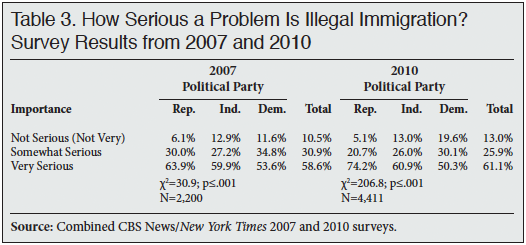
Immigration is only one among a number of issues that voters care about, and it is common enough for candidates to be elected to public office independently of their positions on specifics. The disconnect between voters and elites on this and other issues is the result of public inattentiveness coupled with the varying extent to which issues inform voting across geographic locations and time. Moreover, a large share of voters is known not to have coherent policy opinions making them unable to send clear and precise signals to candidates. Still others weigh competing issue considerations, holding cross-cutting policy viewpoints, opening them up to swing voting and leaving candidates uncertain.6 But in recent years, with rival party bases taking opposite positions on immigration policy, candidates have less justification for ignoring resonant themes.
Even the tables shown above imply that immigration is not a preeminent political consideration for everyone, any more than gay marriage or free trade. But one circumstance that has greatly enhanced immigration’s linkage to vote choice is the prolonged recession, and the vague impression that illegal immigrants are prospering at the expense of natives.
Others have also suggested that the slow economic recovery since the Great Recession began has defined immigration as a contentious issue. The return of jobs and prosperity has been sufficiently slow that for many it feels far more like a restructuring that has left them permanently worse off, rather than a short-term adjustment they need to merely wait out.
Economists have advanced multiple explanations for the uneven recovery, but rarely do they cite immigration as an aggravating factor. If anything, the dominant economic view is that legalization and a more generous immigration policy would bring about economic recovery.7 Clearly voters fail to see it this way, particularly those on the lower and middle rungs of the socioeconomic ladder who have not experienced the benefits of immigration in the same way as the well-off.
Immigration Opinion as a Response to Slow Recovery
For evidence that the importance of immigration as an issue has been fueled by economic downturn, research requires surveys that ask respondents to assess the state of the economy or to judge the pace of economic recovery. Most social scientists realize that retrospective economic assessments are important guides for many types of decisions, with some voters relying heavily on economic appraisals to decide their vote.8
A number of surveys are available to document the association between economic outlook and immigration opinion in the lead-up to 2015. The results are mostly consistent so only a few need to be shown here to punctuate the argument.
In December 2014 and again in May 2015, the Pew Research Center asked survey respondents to choose between two basic options for managing illegal immigration: “Which comes closer to your view about how to handle undocumented immigrants who are now living in the U.S.? 1) They should not be allowed to stay in the country legally [OR] 2) There should be a way for them to stay in the country legally, if certain requirements are met.”
Social scientists might critique the Pew question wording on multiple grounds. Some would question the use of the term “undocumented” rather than “illegal”, while others would complain that the requirements for staying in the country in option two remain unspecified. The option of not allowing illegal aliens to stay in the country, by implication a call for deportation, will strike some as an unrealistic choice to offer as a response. In spite of these limitations, sharp partisan disagreement appears in both surveys, with far more Democrats than Republicans favoring the legalization option. In the May survey, only weeks before Donald Trump announced his candidacy, Pew also asked routine questions about the national economy, personal finances, and whether the economy had recovered from the recession. Table 4 shows the deep impact of these economic assessments.
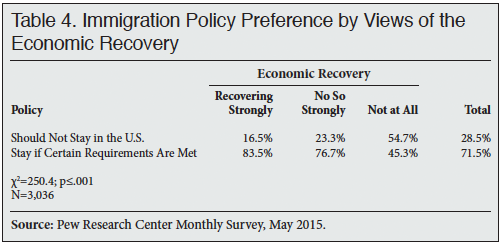
First, most respondents are at least somewhat forgiving, saying they’re willing to allow illegal immigrants to remain so long as certain (unspecified) requirements are met. This result is consistent with other surveys showing that a policy of outright removal of more than 11 million illegal immigrants is thought to be extreme and impractical.
Viewpoints do shift markedly, however, comparing those who believe that the economic recovery has been strong to those who think that the economy has not recovered at all. More than half of those doubting that any recovery has occurred take a hard line position, compared to only 16.5 percent of those who claim the economy has made a strong recovery, a 38 percentage-point gap (see Table 4).
Assessments of the economy are also known to be related to party identification, education, and age. Certainly older voters and those with middling levels of education are more likely to support stricter immigration enforcement. But the impact of recession experience on policy opinion remains robust even after controlling for these alternative explanations (see Appendix Table A3). From this evidence it can be concluded that keeping economic and immigration grievances in close rhetorical proximity was smart politics, whether Trump was studying Republican opinion or just sensing its unambiguous direction.
These findings will not be novel to researchers familiar with the history of research on this issue. Immigration becomes more controversial in times of economic hardship. Few generalizations in social science stand-up to empirical scrutiny as well as this one.
As a final piece of evidence, the Palo Alto-based research firm YouGov drew on their very large internet panel of nationally representative survey respondents in each October in 2010, 2012, 2014, and 2015 to gauge opinion on several immigration policy options. Their query requires a simple yes/no reply to a proposal to grant “legal status to illegal immigrants who have held jobs and paid taxes for at least three years and have no felony convictions.” They also ask a routine question asking for an evaluation of national economic conditions. The expectation, following from Table 4 from the Pew study, is that negative evaluations of economic conditions will be closely associated with views contrary to legalization, and that this pattern will show up across all four surveys, not just in the 2010 survey closer to the Great Recession’s low point.9
The results in Table 5 generally show that positive evaluations of the national economy are associated with more lenient attitudes toward illegal immigration through support for legalization. Even in 2010, in the middle of the economic crunch, the 61 percent who reported that the economy had “gotten much better” indicated that legalization was an acceptable policy option, compared with only 14 percent of those who indicated that the economy had “gotten much worse”.

By 2015, this gap had grown even wider, to 50 points, separating those at the two extremes of economic evaluation (see Table 5). Well after the recession had been declared “over”, voters’ grim assessments of the national economy were shaping their views on immigration policy. Whatever else may condition immigration policy views; these results do not leave much doubt about how economic anxieties are related to views about the legalization of undocumented immigrants.
Conclusions
Donald Trump’s rapid rise in the early months of the 2016 campaign cycle may be surprising, but a bigger surprise is why no other candidates emphasized immigration control, either in 2015 or earlier, when multiple sources showed the same distribution of opinion. As we have seen, opposition to the legalization of illegal immigrants did not suddenly materialize in late 2014, either among Republicans or among the public at large. Rather, the viewpoints of GOP regulars have been ignored for a long time, certainly as far back as the beginning of the Great Recession. This collection of facts should resolve part of the puzzle of how such an improbable outsider won the Republican nomination.
Immigration positioning not only qualified Trump for the nomination as far as primary voters were concerned, but it also proved disqualifying for Jeb Bush and Marco Rubio, the leading alternatives. In this development, we were reminded, once again, of the limits of the power of big-money insiders in major elections. If the Brahmin GOP donors had their way, someone else would have won the nomination. Republican leaders unhappy with Trump are now left wondering how they might regain control of the nomination process so as to structure the outcome more securely next time.
None of this is to argue that Trump’s position on wall-building or other immigration control measures are going to be winners in the 2016 general election. His stands may help and hurt in equal measure, winding up neutral in impact. For their part, independent voters are not very issue-oriented in their decision making, when they vote at all, and probably care little and know even less about the candidates’ views on specific policies.
Nor does anything in this paper suggest that going out of one’s way to antagonize Latino or immigrant voters, rather than sticking to a disciplined discussion of immigration policy options, is a winning strategy for the general election. Favoring a stricter immigration policy does not alienate every Latino or immigrant voter. To say so is to assert that all immigrants share the same view of immigration policy. At the same time, these voters will be easily alienated by attacks that go less to policy choices and more to their ethnic and nationality background.
Finally, we see that views about immigration policy are not the only matters that separate elites from masses within the GOP. Arguably, economic experiences have become very different as well. As Charles Murray has emphasized, the people who are most actively seeking to exercise influence on government have little or no direct experience with the lives of ordinary Americans. They “make their judgments about what’s good for other people based on their own highly atypical lives.”10 Misjudgments by the leading Republican campaigns about immigration policy are only half the story. The other half is their apparent cluelessness about the enduring economic hardships and uncertainties produced by economic restructuring.
The great irony is that someone who has lived a life as secure and insular as Donald Trump wound up with a sense of rank-and-file opinion so much clearer than politicians whose business it is to accurately perceive what their voters think. One can only conclude that there must be a powerful source of signal distortion hovering around Washington, D.C., such that political elites become desensitized to the concerns and problems of typical citizens. The mass media used to facilitate this connection, but they are no longer viewed as credible, objective sources of information. A durable reconnection of electors to the elected is not likely to be found in the nomination of an odd and impulsive outsider so much as it is in more lasting changes aimed at removing the obstacles to clear message transmission.
Appendix Tables
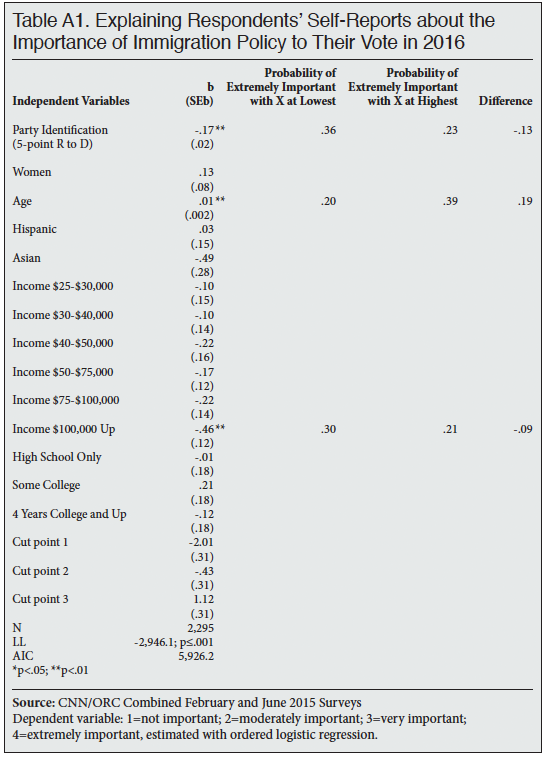
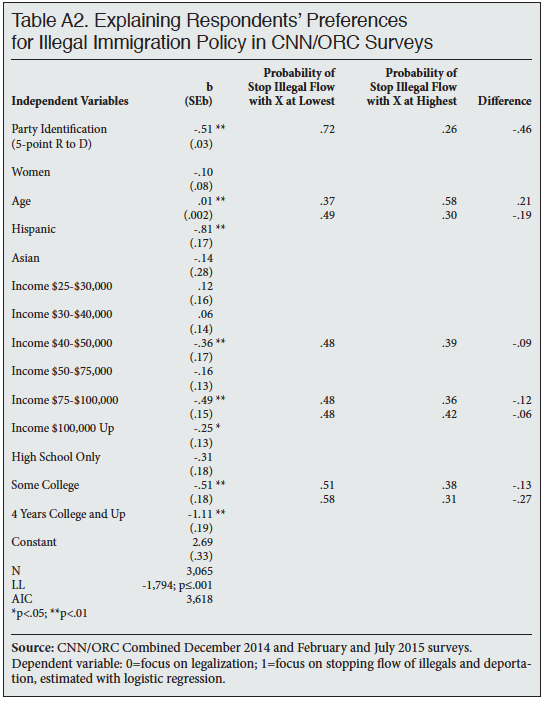

End Notes
1 For details, see the Trump campaign website, accessed June 5, 2016.
2 Deniz Cam, “Billionaires Rally Around Immigration, Against Trump’s ‘Xenophobia’”, Forbes, March 12, 2016. Accessed June 4, 2016. Ashley Parker, “Big-Name G.O.P. Donors Urge Members of Congress to Back Immigration Overhaul”, The New York Times, July 31, 2013. Accessed June 4, 2016. Laura Meckler, “Some GOP Donors Step Up Immigration Push”, Wall Street Journal, October 23, 2013. Accessed June 4, 2016.
3 Salil Kapur, “Rubio’s Immigration Efforts Haunt His Presidential Ambitions”, Bloomberg News, November 3, 2015. Accessed June 5, 2016. McKay Coppins, “Marco Rubio Rakes In Donor Money By Touting Immigration Record — Behind Closed Doors”, BuzzFeed News, April 22, 2015. Accessed June 5, 2016.
4 For a summary of opinion trends based on Pew Research Center polls, see Dara Lind, “One Chart Shows Why the Republican Party was Ready for Donald Trump”, Vox, May 3, 2016. Accessed June 6, 2016.
5 Measures of statistical association between party identification and the seriousness of illegal immigration nearly double between 2007 and 2010.
6 This viewpoint on swing voters is spelled out in D. Sunshine Hillygus and Todd G. Shields, The Persuadable Voter: Wedge Issues in Political Campaigns, Princeton, NJ: Princeton University Press, 2006.
7 David Frum, “Does Immigration Harm Working Americans?” The Atlantic, January 5, 2015. Accessed June 4, 2016. George J. Borjas. 2013. “Immigration and the American Worker”, Center for Immigration Studies Backgrounder, April, 2013.
8 For a general statement, see Chapter 13 of Michael S. Lewis-Beck, William G. Jacoby, Helmut Norpoth, and Herbert F. Weisberg, The American Voter Revisited, Ann Arbor, Mich.: The University of Michigan Press, 2008. A classic statement on economic voting can be found in Chapter 14 of Angus Campbell, Philip E. Converse, Warren E. Miller, and Donald E. Stokes, The American Voter, New York: John Wiley & Sons, 1960. On how economic evaluations are politicized, see Alan S. Gerber and Gregory A. Huber, “Partisanship, Political Control and Economic Assessments”, American Journal of Political Science 54: 1: 153-173, 2009. On the origins of national economic evaluations, see Andrew Reeves and James G. Gimpel, 2012. “Ecologies of Unease: Geographic Context and National Economic Evaluations”, Political Behavior 34: 3: 507-534, 2012.
9 Objective economic conditions may be less relevant to opinion than a lingering or persistent threat of economic hardship. See Judith L. Goldstein and Margaret E. Peters,“Nativism or Economic Threat: Attitudes toward Immigrants During the Great Recession”, International Interactions 40: 3: 376-401, 2014.
10 Charles Murray, Coming Apart: The State of White America, 1960-2010, New York: Crown Forum, 2012, p. 105.
